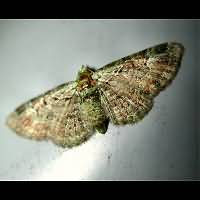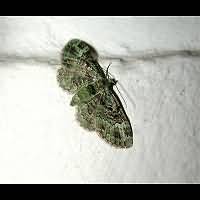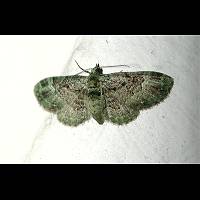Green Pug (Rhinoprora rectangulata)
The Green Pug is green and thus quite easy to identify. Well almost. If you see a greenish pug, first look at the underside of the forewing. A pug with a clearly marked band there belongs to the genus Rhinoprora. If the underside is not clearly marked it belongs to the genus Chloroclystis. Of the Rhinoprora-species (Green Pug, Billberry Pug and Sloe Pug), the Green Pug is most common. The Billberry Pug is somewhat similar, but has no dark bands on its wing, but a series of dots, something we never see on the Green Pug's. The Sloe Pug usually is darker, has faint markings and is less green. The only real similar species is the V-pug. It being a Chloroclystis lacks the markings on the underside of the forewing and has a clear V-sign on the upperside, something never found in the Green Pug. The green usually becomes a kind of brasslike colour in older specimens, not unusual in green Geometers. The amount of green also depends on the light, as can be seen in the pictures, and on the angle of looking at the animal. Some melanistic forms exist, which are difficult to identify. Seeing one of those will mean you'll have to take your field guides, trying to identify the specimen. The wingspan of the Green Pug is some 17 to 22 mm, typical for a Pug.
Females lay their eggs in June on the host plants. And the eggs stay there during summer, autumn and the winter of next year, only to hatch in early spring. It is the moment the new flowerbuds of the host plants start growing. The caterpillar is quite short, but thicker compared to the larvae of other Geometers. It only eats flowerbuds and flowers, living inside or weaving a few flowers together. It grows quickly. The larvae can be found on wild and cultivated apples, pears, cherries and peaches, as well as on hawthorn and blackthorn. It is harmful in breeding fruits. Insecticides and other means are deployed to fight this species. And even though it is not as numerous as it used to be, it is still one of the most common pugs, probably because its caterpillar lives on hawthorn and blackthorn as well.
Because the caterpillar lives on flowers exclusively, the Green Pug is single-brooded. It is on the wing from the end of April to the beginning of August, but most numerous in June. The moth only flies at night, but can be disturbed during day time. It is attracted to light easily. A common species, often appearing in great numbers locally, in England and Wales. Probably well distributed over most of Ireland. A rather local species in Scotland. In other parts of Europe a common, but sometimes local species.
NB In Skinner the Green Pug is still called Chloroclystis rectangulata. In Waring etc. the scientific name Pasiphila rectangulata is used.
The Green Pug is green and thus quite easy to identify. Well almost. If you see a greenish pug, first look at the underside of the forewing. A pug with a clearly marked band there belongs to the genus Rhinoprora. If the underside is not clearly marked it belongs to the genus Chloroclystis. Of the Rhinoprora-species (Green Pug, Billberry Pug and Sloe Pug), the Green Pug is most common. The Billberry Pug is somewhat similar, but has no dark bands on its wing, but a series of dots, something we never see on the Green Pug's. The Sloe Pug usually is darker, has faint markings and is less green. The only real similar species is the V-pug. It being a Chloroclystis lacks the markings on the underside of the forewing and has a clear V-sign on the upperside, something never found in the Green Pug. The green usually becomes a kind of brasslike colour in older specimens, not unusual in green Geometers. The amount of green also depends on the light, as can be seen in the pictures, and on the angle of looking at the animal. Some melanistic forms exist, which are difficult to identify. Seeing one of those will mean you'll have to take your field guides, trying to identify the specimen. The wingspan of the Green Pug is some 17 to 22 mm, typical for a Pug.
Females lay their eggs in June on the host plants. And the eggs stay there during summer, autumn and the winter of next year, only to hatch in early spring. It is the moment the new flowerbuds of the host plants start growing. The caterpillar is quite short, but thicker compared to the larvae of other Geometers. It only eats flowerbuds and flowers, living inside or weaving a few flowers together. It grows quickly. The larvae can be found on wild and cultivated apples, pears, cherries and peaches, as well as on hawthorn and blackthorn. It is harmful in breeding fruits. Insecticides and other means are deployed to fight this species. And even though it is not as numerous as it used to be, it is still one of the most common pugs, probably because its caterpillar lives on hawthorn and blackthorn as well.
Because the caterpillar lives on flowers exclusively, the Green Pug is single-brooded. It is on the wing from the end of April to the beginning of August, but most numerous in June. The moth only flies at night, but can be disturbed during day time. It is attracted to light easily. A common species, often appearing in great numbers locally, in England and Wales. Probably well distributed over most of Ireland. A rather local species in Scotland. In other parts of Europe a common, but sometimes local species.
NB In Skinner the Green Pug is still called Chloroclystis rectangulata. In Waring etc. the scientific name Pasiphila rectangulata is used.









